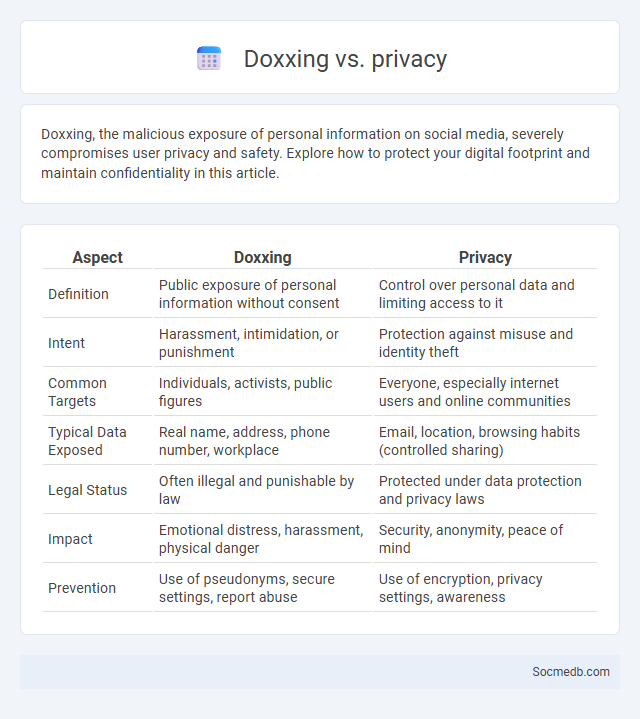
Photo illustration: doxxing vs privacy
Doxxing, the malicious exposure of personal information on social media, severely compromises user privacy and safety. Explore how to protect your digital footprint and maintain confidentiality in this article.
Table of Comparison
| Aspect | Doxxing | Privacy |
|---|---|---|
| Definition | Public exposure of personal information without consent | Control over personal data and limiting access to it |
| Intent | Harassment, intimidation, or punishment | Protection against misuse and identity theft |
| Common Targets | Individuals, activists, public figures | Everyone, especially internet users and online communities |
| Typical Data Exposed | Real name, address, phone number, workplace | Email, location, browsing habits (controlled sharing) |
| Legal Status | Often illegal and punishable by law | Protected under data protection and privacy laws |
| Impact | Emotional distress, harassment, physical danger | Security, anonymity, peace of mind |
| Prevention | Use of pseudonyms, secure settings, report abuse | Use of encryption, privacy settings, awareness |
Understanding Doxxing: Definition and Origins
Doxxing refers to the practice of publicly revealing private or identifying information about an individual without their consent, often with the intent to harass or intimidate. Originating from the term "dropping dox" in hacker communities of the early 2000s, it involves collecting data such as home addresses, phone numbers, or workplace details from online sources. The rise of social media platforms has amplified the prevalence and impact of doxxing, making digital privacy protection a critical concern.
Privacy in the Digital Age
Protecting your privacy in the digital age requires careful management of personal data shared on social media platforms. Understanding each platform's privacy settings and adjusting them to limit data exposure reduces the risk of unauthorized access and identity theft. Regularly reviewing app permissions and being cautious about the information you post empowers you to maintain control over your digital footprint.
What Constitutes Personal Information?
Personal information on social media includes data that can identify an individual, such as full name, date of birth, email address, phone number, and physical address. It also encompasses sensitive information like biometric data, location history, social security numbers, and financial details. This information is often collected, shared, and potentially exploited through social media platforms, highlighting the importance of privacy settings and data protection measures.
Doxxing vs. Privacy: Key Differences
Doxxing involves the malicious exposure of your private information online, often leading to harassment or identity theft. Privacy on social media emphasizes safeguarding your personal data through settings that control who can access your information. Understanding these key differences helps you protect your digital footprint and maintain control over your online presence.
How Doxxing Compromises Personal Information
Doxxing exposes personal information by publishing sensitive data such as home addresses, phone numbers, and private email accounts online without consent. This breach of privacy increases the risk of identity theft, harassment, and physical threats for the targeted individuals. Social media platforms often amplify the spread of doxxed details due to their wide reach and rapid information sharing capabilities.
Legal Implications of Doxxing
Doxxing involves the unauthorized sharing of private information online, raising significant legal implications including privacy violations, harassment, and potential civil lawsuits. Laws such as the Computer Fraud and Abuse Act (CFAA) and various state-level privacy statutes address doxxing-related offenses, imposing penalties on perpetrators. Victims can seek legal recourse through restraining orders, criminal charges, and claims for damages stemming from emotional distress or reputational harm.
Protecting Your Privacy Online
Protecting Your privacy online involves using strong, unique passwords and enabling two-factor authentication across your social media accounts. You should regularly review privacy settings to control what information you share and who can see your posts on platforms like Facebook, Instagram, and Twitter. Being cautious about clicking links and sharing personal details helps reduce the risk of hacking and identity theft on social media.
Recognizing Risks: Signs of Being Targeted
Recognizing risks on social media involves identifying signs such as sudden increases in friend requests from unknown individuals, frequent unsolicited messages containing suspicious links, and the appearance of fake profiles mimicking your identity. Awareness of targeted phishing attempts, cyberbullying patterns, and unusual account activity like unexpected password changes can indicate potential threats. Monitoring privacy settings and using two-factor authentication help mitigate these risks and protect personal information from social media attacks.
Preventing Personal Information Doxxing
Protecting personal information on social media platforms is crucial to prevent doxxing, which involves the malicious exposure of private data. Users should employ strong privacy settings, limit the sharing of sensitive details, and utilize two-factor authentication to enhance account security. Regularly reviewing and updating security preferences reduces the risk of identity theft and unauthorized access.
Responding to Doxxing Incidents
Responding to doxxing incidents requires immediate action to protect your personal information and online safety. You should report the incident to the platform administrators and law enforcement agencies to ensure proper documentation and investigation. Implement privacy settings and consider using identity protection tools to minimize further risks from exposing sensitive data.
 socmedb.com
socmedb.com